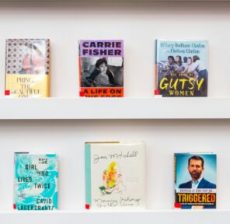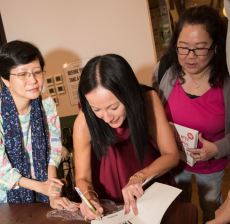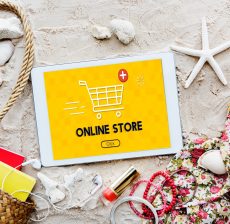
TRADITIONAL PUBLISHING
Traditional publishing entails landing a book deal with a mainstream publisher.
Given their know-how and expertise, the publisher helps to handle the editing, design, production and distribution of your book.
Pros:
- The publisher takes care of the entire creative process and distribution.
- There’s fewer upfront costs to you as the publisher covers production expenses.
- The publisher can share knowledge on what sells and makes a book attractive.
- It’s easier to setup a distribution and bookstore network as they have the contacts.
- You get instant clout and credibility from association with an industry heavyweight.
- You have more time to focus on writing as a publisher handles the heavy lifting.
- The publisher might pay you an advance on royalties.
Cons:
- It’s tricky to get a book accepted by a traditional publishing house.
- You must secure an agent as the ‘big guys’ often refuse unsolicited manuscripts.
- Going down this route can prove a lengthy, drawn out exercise with no guarantees.
- Dealing with ‘rejection after rejection’ is soul destroying and demoralising.
- Once you sign a contract, the publisher owns the rights to your book.
- There’s room for disagreements due to differences in opinion.
- The publisher has the final say on the manuscript and design.
- Despite the publisher handling production, marketing is your responsibility.
- Royalty rates are less for you as profits are shared.
SELF-PUBLISHING
Self-publishing is where you publish your book without the assistance of a traditional publisher.
If you publish yourself, you manage the editing, design, production, promotion and distribution.
You also deal directly with your book’s editor, designer, printer and distributors.
Pros:
- You have full autonomy over your book project.
- You maintain ownership and book rights.
- You keep control of the creative process and all decisions.
- You can publish faster and more efficiently.
- You don’t have to deal with endless rejections.
- You get to learn about the different stages of editing, design, print and production.
- You have higher earning potential.
- You can set up a business and benefit from the tax breaks.
Cons:
- It can be overwhelming to oversee the entire publishing process yourself.
- You must be self-driven as there’s no one to hold you accountable.
- You have to cover upfront costs and publish at your own expense.
- You won’t have the support and guidance of a publisher.
- Without proper quality control measures in place, standards maybe compromised.
- You’re likely to have a smaller distribution network behind you.
- If you produce printed books, you have to find a suitable place to store them.
Whether you elect to self-publish to work with a traditional publisher comes down to personal circumstance and preference.
The best way forward is therefore to make an educated decision based on what makes the most sense to you.

Here’s a step-by-step checklist to self-publish a book:
- Pick a subject with market potential.
- Define your book’s goals.
- Write your first draft.
- Collate photos and illustrations.
- Choose a catchy title.
- Conduct a self-edit.
- Solicit book reviews.
- Apply for an ISBN.
- Hire a professional book editor.
- Decide your book’s format, e.g. print, e-book etc.
- Appoint a graphic designer to typeset and layout.
- Work on your cover design.
- Proofread the typeset version.
- Order proof copies to check errors/paper stock/print treatments.
- Prepare your final e-book/print book files.
- Print/publish your book.
- Price your book.
- Set up sales and distribution channels.
- Plan your book launch campaign.
- Continue to promote your book.
You can download a PDF copy of the above checklist here.

Writer’s block is a frigging nightmare. There’s no need to panic though as everyone has days when the words won’t flow.
During times when you can’t get your thoughts down, don’t beat yourself up. Instead, ask yourself – is there something else I can do? If you’re having difficulties with a certain chapter, can you skip to another section and revisit it later?
Or, can you do some research, brainstorm bullet points or work on another aspect of your book project so it feels like you’re making progress?
Writing is not meant to be hard work. Besides, authoring a book is something you’ve chosen to do.
So, don’t feel guilty about taking a break. Sometimes, your best ideas might come when you’re not at your computer.
If you’re stuck in a rut, a change of scenery like exercise, listening to music or getting fresh air can clear the mind and re-energise you.
Lastly, end productive writing days on a good note. Quit whilst ahead and plan what to work on the next day. By knowing what’s coming next, you’re more likely to jump straight into it.
An ISBN is a unique identification number for a published book.
Short for International Standard Book Number, you usually find a book’s ISBN on its back cover, alongside a bar code.
As a product identifier, an ISBN stores details about a book’s title, author, publisher and edition to make it easy for readers, bookstores, online retailers and libraries to find.
In contrast, a book’s barcode visually communicates an ISBN to scanning technology to simplify the inventory management and sales transaction process.
Given the above, it’s advisable even for self-publishers to apply for an ISBN. All printed books need an ISBN, whereas e-books don’t. However, be aware that distributors, book chains and Internet stores might not accept your book if it doesn’t have an ISBN.
You also need unique ISBNs for different formats and editions of your book. Let’s say, hard cover, soft cover, audio and digital. Don’t worry though as you can easily acquire ISBNs in blocks of 10, 100 or more.
All you have to do is to apply to the designated agency in your country that issues ISBNs. For example, if you live in:
* the United States, apply through Bowker.
* the United Kingdom, apply through the Nielson ISBN Agency.
* Canada, apply through ISBN Canada.
* Hong Kong, apply through the Book Registration Office.
* Australia, apply through Thorpe-Bowker.
In some countries ISBNs are free, whereas in others you have to pay.
Not only that, but if you’re working through a self-publishing platform like Amazon KDP or Kobo you can opt to be assigned an ISBN from their own series. With this option, please note the publishing services firm is listed as the publisher, not you.
Once you receive your block of ISBNs, simply assign a unique ISBN to each version of every book you publish. Next is to create a bar code from your ISBN.
To do so, you either require software that generates a bar code. Otherwise, you can use an online service like TEC-IT Barcode Generator or Creative Indie Covers Barcode Generator to produce a bar code file for you.
You can then pass the file to your graphic designer to incorporate into the design of your book’s back cover.

It varies depending on the type of book you’re publishing and available budget. A glossy, hard back coffee table book will set you back more than a standard A5 paperback.
Given each book differs in length, size, finishing and quantity, it’s fair to say you can self-publish for as much or as little as you can afford.
Recent statistics suggest the typical independent author spends between USD 1,500 and USD 5,500. Most of this budget is likely to go towards services like:
- Professional editing and proofreading
- Graphic design
- Typesetting
- Photography/illustrations
- Printing
From JEM’s experience, we tend to set aside USD 10,000 for each of our printed, standard paperback projects. The reason being further expenses are often incurred after production.
You might have to fork out for marketing items like bookmarks, flyers, press releases, social media and email campaigns, as well as catering and transportation for events.
Take note too that contractors like graphic artists and printers may request you pay in instalments, e.g. an initial 50% deposit upfront with the 50% balance payable on work completion.

To determine what your book is worth, a good starting point is to study the range of prices of similar books in your genre.
Try to get an idea of what your target reader is prepared to spend. Visit your local book store to check the pricing of comparative titles in your category.
Look at online stores like Amazon.com. Don’t forget to compare the price of equivalent hard cover, e-book and audio versions.
Log the various book titles and pricing details you collate into a chart. Once you have a sufficient sample, clear trends and pricing averages will emerge.
Keep in mind the figure you decide on is not necessarily the amount you earn. All parties in the book selling chain from wholesalers and distributors to retailers and digital stores take a cut, e.g. book retailers can take a 40% commission!
Factor in what you paid to produce your book. Calculate all your expenses (design, editing, printing etc.) and divide by your print quantity to work out a cost per copy.
As an author, you must market your book. Roughly expect to direct around 25% of your list price back into your book’s promotion.
Although you may wish to charge customers a fair price, you can instantly see from the above that you need a price high enough to cover your outlays, let alone make a profit.
Typically, whatever your distribution channel, you want to make several dollars in margin on each copy sold. Pricing may also vary for different formats.
Another tip is to end your pricing in an odd number like $.95 or $.99. Psychologically, for the consumer, it’s seems less expensive.

Bingo – lucky for you, JEM’s Founder Jan has been in the PR business for over 25 years during which time she has worked on the launch of countless books.
Now as a published author herself, here are some of the marketing techniques that Jan uses to promote her own books.

If you’ve a book that’s ready to go, simply follow these steps:
- First up, visit kdp.amazon.com and sign up for an account. (We suggest keeping your book seller’s account separate from any regular shopping account).
- After logging in, go to Bookshelf. There will be a notification that reads, “Your account information is incomplete. Click on Update Now.
- Under the My Account option, click on Author/Publisher and enter your country, address and phone details.
- Under Getting Paid, enter your bank details.
- Next, click on Tax Information and input your tax details.
- Remember to click Save after inputting all entries.
- Once the above KDP account setup is complete, go back to Bookshelf.
FOR YOUR PRINT VERSION
- Click on Create a New Title and complete details. (e.g. + paperback, language, book title, series (optional), edition number (optional), author, contributors, description, publishing rights, adult content yes/no, primary marketplace, categories, keywords, publication date and release date). Click Save and Continue.
- Click on the Content Tab and work through the following:
– enter your ISBN
– input your Publication Date
– state your Print Options
– for Manuscript, upload a PDF version of your books with fonts embedded
– for Book Cover, upload your own cover (note the checkbox)
– under Book Preview, click Launch Previewer. This may take a few minutes.
Once the preview appears, check everything is okay or fix errors. Click
Approve when you are happy. Make sure to Save and Continue.
FOR YOUR E-BOOK VERSION
To upload an e-book version of your book, you need a doc, docx, HTML. MOBI, ePub, RTF, Plain Text or KPF file of your book ready to go.
You also require a rectangular book cover image either in JPEG or TIFF format. (A good file size is 2,560 x 1,600 pixels).
- Navigate to Bookshelf but this time hit Create Kindle eBook.
- If you previously entered details for a print version, this information rolls over automatically. If not complete the details.(e.g. language, book title, series (optional), edition number (optional), author, contributors, description, publishing rights, adult content yes/no, primary marketplace, categories, keywords, publication date and release date. Click Save and Continue.
-
Click on the Kindle Content Tab and work through the following:
– under Manuscript, pick No on Digital Rights Management and upload your e-
book file.
– next, upload your Kindle eBook Cover
– under the Kindle eBook Preview, click Launch Previewer. As before, check
and confirm everything looks okay. (Navigate back by either clicking on
Book Details or use your browser’s back arrow).
– enter your Kindle eBook ISBN (optional)
– Save as Draft or Publish Your Kindle eBook.
Please note that any books you list have to go through Amazon’s approval process. As soon as approved, you book is available to purchase.

They say everyone has a book inside them.
Can I Have a Word is a campaign designed to help aspiring authors get their book out into the world by offering tips and resources on book planning, writing, self-publishing and promotion.

We’ve got your back.
Here’s some places and spaces to find more support and information.
You might also like our ‘Hit Lists.‘ They’re compilations of our favourite resources for authors from books and masterclasses to podcasts, writing tools, gifts and much more.

